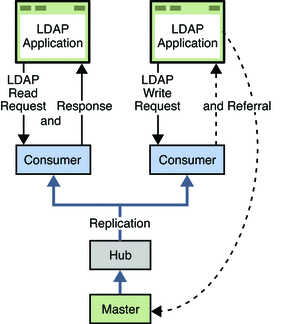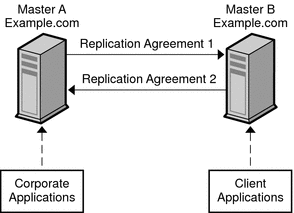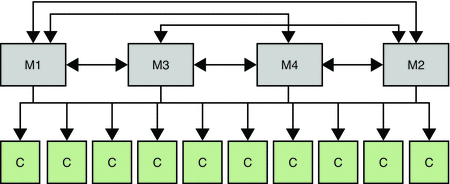Using Replication for Load Balancing
Replication is the mechanism that automatically copies directory data and changes from one directory server to another directory server. With replication, you can copy a directory tree or subtree that is stored in its own suffix between servers.
Note –
You cannot copy the configuration or monitoring information subtrees.
By replicating directory data across servers, you can reduce the access load on a single machine, improving server response time and providing read scalability. Replicating directory entries to a location close to your users also improves directory response time. Replication is generally not a solution for write scalability.
Basic Replication Concepts
The replication mechanism is described in detail in Chapter 7, Directory Server Replication, in Oracle Fusion Middleware Reference for Oracle Directory Server Enterprise Edition. The following section provides basic information that you need to understand before reviewing the sample topologies described later in this chapter.
Master, Consumer, and Hub Replicas
A database that participates in replication is defined as a replica.
Directory Server distinguishes between three kinds of replicas:
-
Master or read-write replica. A read-write database that contains a master copy of the directory data. A master replica can process update requests from directory clients. A topology that contains more than one master is called a multi-master topology.
-
Consumer replica. A read-only database that contains a copy of the information in the master replica. A consumer replica can process search requests from directory clients but refers update requests to master replicas.
-
Hub replica. A read-only database (like a consumer replica) that is stored on a Directory Server that supplies one or more consumer replicas.
The following figure illustrates the role of each of these replicas in a replication topology.
Figure 10–1 Role of Replicas in a Replication Topology

Note –
The previous figure is for illustration purposes only and is not necessarily a recommended topology. Directory Server supports an unlimited number of masters in a multi-master topology. A master-only topology is recommended in most cases.
Assessing Initial Replication Requirements
A successful replicated directory service requires comprehensive testing and analysis in a production environment. However, the following basic calculation enables you to start designing a replicated topology. The sections that follow use the result of this calculation as the basis of the replicated topology design.
 To Determine Initial Replication Requirements
To Determine Initial Replication Requirements
-
Estimate the maximum number of searches per second that are required at peak usage time.
This estimate can be called Total searches.
-
Test the number of searches per second that a single host can achieve.
This estimate can be called Searches per host. Note that this should be evaluated with replication enabled.
The number of searches that a host can achieve is affected by several variables. Among these are the size of the entries, the capacity of the host, and the speed of the network. A number of third party performance testing tools are available to assist you in conducting these tests. The SLAMD Distributed Load Generation Engine (SLAMD) is an open source Java application designed for stress testing and performance analysis of network-based applications. SLAMD can be used effectively to perform this part of the replication assessment. For information about SLAMD, and to download the SLAMD software, see http://www.slamd.com.
-
Calculate the number of hosts that are required.
Number of hosts = Total searches / Searches per host
Load Balancing With Multi-Master Replication in a Single Data Center
Replication can balance the load on Directory Server in the following ways:
-
By spreading search activities across several servers
-
By dedicating specific servers to specific tasks or applications
Generally, if the Number of hosts calculated in Assessing Initial Replication Requirements is about 16, or not significantly larger, your topology should include only master servers in a fully connected topology. Fully connected means that every master replicates to every other master in the topology.
Note –
The Number of hosts is approximate and depends on the hardware and other details of the deployment.
The following figure assumes that the Number of hosts is two. LDAP operations are divided between two master servers, based on the type of client application. This strategy reduces the load that is placed on each server and increases the total number of operations that can be served by the deployment.
Figure 10–2 Using Multi-Master Replication for Load Balancing

For a similar scenario in a global deployment, see Multi-Master Replication Over WAN.
Load Balancing With Replication in Large Deployments
If your deployment requires a Number of hosts significantly larger than 16, you might need to add dedicated consumers to the topology.
The following figure assumes that the Number of hosts is 24 and, for simplicity, shows only a portion of the topology. (The remaining 10 servers would have an identical configuration, with a total of 8 masters and 16 consumers.
Figure 10–3 Using Multi-Master Replication for Load Balancing in a Large Deployment

A change log can be enabled on any of these consumers if you need to do the following:
-
Promote the consumer to a master in the event of an outage
-
Perform a binary initialization from a master to any one of the consumers
If the Number of hosts is several hundred, you might want to add hubs to the topology. In such a case, there should be more hubs than masters, with up to 10 hubs for each master. Each hub should handle replication to only 20 consumers at most.
No topology should have the same number of hubs as masters, or the same number of hubs as consumers.
Note –
Configuring a “one-way” master (a master that receives replication changes but does not send them) in a multi-master topology is not recommended and can break replication to that master.
Using Server Groups to Simplify Multi-Master Topologies
When the Number of hosts is large, the use of server groups can simplify the topology and improve resource usage. In a topology with 16 masters, the use of four server groups, each containing four masters, is easier to manage than 16 fully meshed masters.
Setting up a such a topology involves the following steps:
-
Configure the 16 masters, without any replication agreements.
-
Create four server groups and include four masters in each group.
-
Set up replication agreements between all the masters in a single group.
-
Set up replication agreements between the first master of each group, the second master of each group, and so forth.
The following figure shows the resulting topology.
Figure 10–4 Server Groups in Multi-Master Topologies

- © 2010, Oracle Corporation and/or its affiliates
